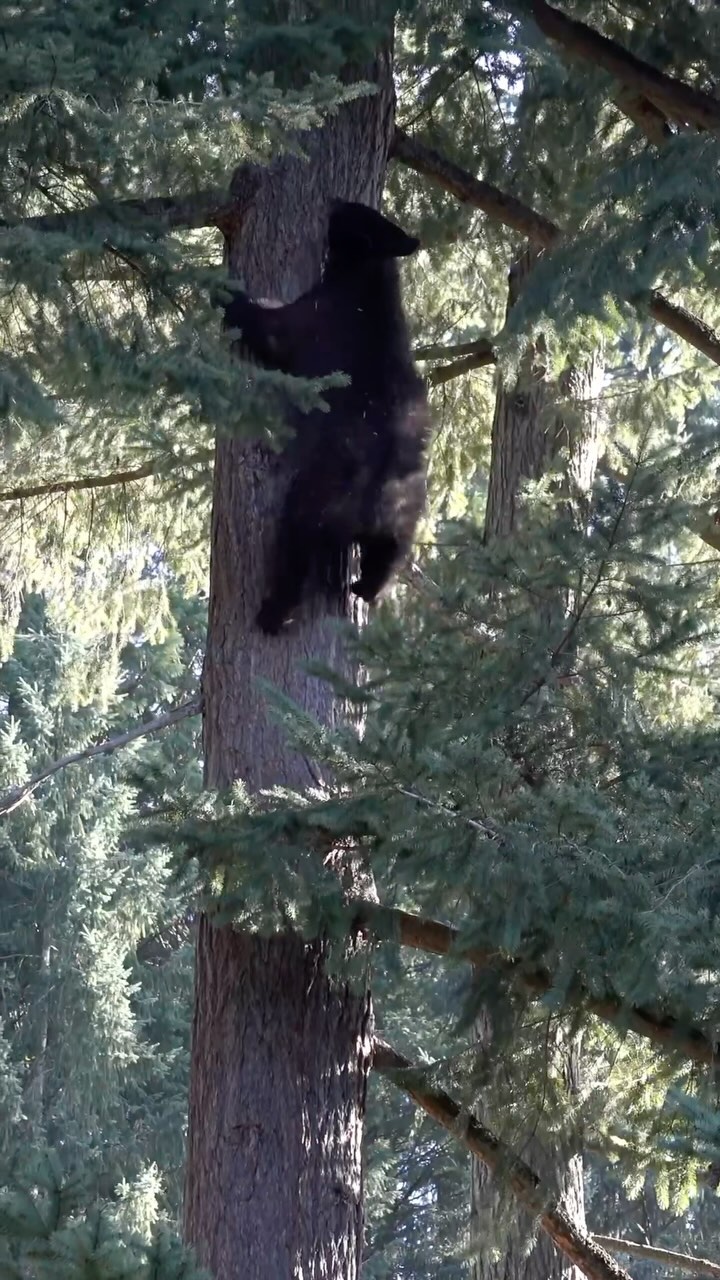– Black bears’ climbing skills and behavioral patterns, particularly in young cubs like Timber and Thorn.
– The role of Douglas fir trees in black bears’ diet and habitat use.
– Challenges and strategies for managing and conserving North American black bear populations in wildlife sanctuaries and the wild.
– The importance of in situ and ex-situ conservation efforts, including wildlife rehabilitation, education, and research, to support bear populations.
– The significance of public engagement and awareness in wildlife conservation efforts through social media platforms.
American black bears (Ursus americanus) are some of North America’s most adaptable and widely distributed bears. Timber and Thorn, two orphaned cubs, exemplify the species’ remarkable ability to climb trees, an essential skill for survival and development.
Black bears are adept climbers, a trait they showcase impressively during their juvenile stages. Thorn’s recent feat of scaling a notably tall Douglas fir tree highlights this capability. By climbing trees, cubs like Timber and Thorn elevate themselves to safety away from potential ground predators and access food sources typically out of reach.
Given their Diet and Nutritional Needs, Douglas fir trees (Pseudotsuga menziesii) serve as a crucial component. These towering conifers offer new vegetative growth this time of year, a source of sustenance for bears in the form of fresh shoots and needles rich in nutrients. Moreover, the trees’ bark and insects found on them can provide additional food for the bears, integrating a balanced diet that also includes a variety of fruits, nuts, and occasionally small mammals or carrion found on the forest floor.
These bear cubs’ climbing habits are an amusing sight and a testament to the species’ resilience. They reflect an instinctive drive shaped by evolutionary pressures enabling access to varied resources and protection, which has inadvertently assisted black bears’ survival amidst a changing environment.
Understanding behaviors such as tree-climbing is pivotal to providing adequate environments for orphaned or injured bears like Timber and Thorn in wildlife sanctuaries and rehabilitation centers. Enclosures must simulate natural habitats as closely as possible, facilitating the development of skills necessary for eventual release back into the wild. This understanding also aids in managing bear populations within protected areas and assessing the species’ overall health and conservation status.
Deforestation and habitat fragmentation pose significant threats to bear populations in the wild. Conserving their habitat, including ensuring the plentiful presence of vital trees like Douglas firs, becomes a central theme in conservation biology. Ensuring pathways for genetic exchange between populations and protecting key regions for forage and denning contribute to the species’ health and longevity. Strategies to mitigate human-bear conflict, such as securing garbage, awareness campaigns, and wildlife corridors, further fortify conservation efforts.
Complementing in situ efforts, ex-situ programs such as captive breeding, public education, and research at wildlife sanctuaries contribute to the comprehensive approach needed for species conservation. These facilities act as sarks for genetic diversity, centers for education to foster wildlife appreciation, and valuable research outposts to better understand bear biology and ecology.
Public engagement and awareness in wildlife conservation play a crucial role. Social media influencers have the power to turn their audience’s attention towards conservation with captivating stories of animals like Timber and Thorn. When harnessed effectively, platforms like Instagram can educate millions on the plight of wildlife and the need for active participation in conservation. These stories help bridge the gap between the public and the often remote world of wildlife conservation, creating advocates for the environment.
Thorn, ascending that beary tall Douglas fir tree, is an excellent focal point to discuss and address critical issues in wildlife conservation. It’s a visual storytelling tool that evokes curiosity, empathy, and a greater understanding of an animal’s life within the broader context of environmental stewardship. By inviting the public to witness such moments, sanctuaries and conservationists can galvanize support, encouraging actions that range from habitat protection to advocating for policy changes—all vital for the future of bears like Timber and Thorn.
Thorn’s climb and the daily life of these bear cubs at the sanctuary provide a snapshot into the engaging world of these majestic creatures. These stories foster a connection with wildlife that transcends regular zoo visits, promoting a message of coexistence and respect. As we witness their growth and learn about their characteristics and needs, we can adapt our actions to support the continued survival of black bears and the rich ecosystems they inhabit.
*****
Source Description
Thorn climbed a very tall tree 🌲
Black bear cubs Timber and Thorn have been scaling the tall Douglas fir trees in their habitat to munch on the tasty new growth near the top. Black bears are known for their climbing ability, and these two—orphaned in the wild—are positive examples!


